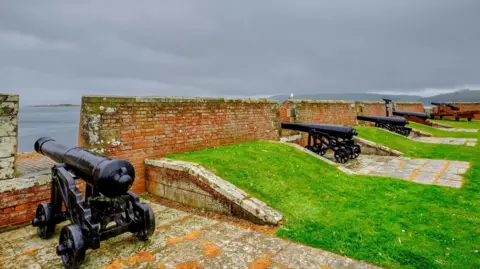Weaving a new future for historic Fort George?
 Getty Images
Getty ImagesA fortress originally built to supress Highland clans and enforce rules preventing clansmen from wearing tartan could become a hub for production of Scotland's famous cloth.
Fort George was constructed after 1746's Battle of Culloden, when Bonnie Prince Charlie and his Jacobite forces were defeated by a government army.
Clans loyal to Charlie were targeted with laws, including one banning the wearing of tartan in the form of Highland dress, which the government regarded as a Jacobite uniform.
There are now calls for tartan weaving to be part of the 255-year-old fortress' future once the Ministry of Defence moves out.

Clare Campbell, of Evanton-based tartan design and weaving business Prickly Thistle, is among those campaigning for the property to be community-owned in the future.
The MoD expects to close Fort George as an army barracks by 2032 as part of wider defence plans.
Clare, who is part of a campaign calling for Highland tartan to be given similar protections as the Western Isles' Harris Tweed, says: "It's a blank canvas.
"The opportunities are vast and we really want to emphasise community engagement," says Clare.
"What do people really want this fortress to be used for?"
Suggestions include using it to host music events and as a base for traditional crafts.
Clare adds: "Imagine the sound of looms going at Fort George.
"I certainly can't wait to see that first piece of tartan woven in Fort George."
Robyn Mackintosh, who works at Prickly Thistle's mill, would like more Highlanders to have the chance to do what she does.
"There is something really beautiful about seeing tartan come to life," she says.
"You can feel the vibrations under your feet. It's very rhythmic, it's very melodic, very meditative."
She adds: "It's an incredible place to work. I think I am very, very lucky in that this is the only place in the Highlands of Scotland where you can weave tartan."
Robyn believes small micro mills could thrive at the large fort, adding: "Let's bring it home, let's keep it here, let's use a facility that is there ready for us."

Dr Nicola Martin, lecturer in history at the UHI Centre for History, says there would be a nice irony if this did happen.
She says: "The intention of the British state after Culloden was to destroy Highland culture because of that association with Jacobitism."
Dr Martin says the Act of Proscription of 1746 was not a blanket ban on tartan, but did target men and boys if found wearing plaid, tartan waist coats and tartan jackets.
"Soldiers were used to implement the act so they would go out and arrest men who they found in garments that were contrary to the Dress Act," she says.

Architect Calum Maclean from the Inverness City Heritage Trust says it is vital a new use is found for Fort George.
He says: "The architecture of the building is really quite staggering.
"It's a massive structure and it was colossally expensive to build. There is nothing quite like it in the UK."
Calum says its position on the Moray Firth exposes it to a risk of damage.
"It gets all the wind and the weather that gets thrown at it and if it is left empty it will really be at risk of falling apart," he says.
 Getty Images
Getty ImagesThe MoD says Fort George was surplus to requirements, and says new accommodation for soldiers based there would be provided at Leuchars in Fife.
Historic Environment Scotland operates large parts of the site as a visitor attraction.
A spokesperson says: "We've been approached by an interested third party about the potential future use of some of the buildings within the site and we'll continue to have dialogue with stakeholders as conversations develop."
